6 - Wave propagation and spectra
Published online by Cambridge University Press: 05 October 2014
Summary
Introduction
So far we have focused mainly upon the dynamics of waves in uniform and stationary ambient fluids. In the case of interfacial waves, we assumed that horizontal boundaries, if present, were flat so that the depth of the ambient was constant. Since interfacial wave speeds are a function of depth the question arises as to how the waves propagate in a medium that, for example, gets shallower approaching a beach. Likewise, for internal waves we have usually assumed that the background stratification is uniform. But we have seen that the stratification varies vertically in both the atmosphere and ocean. Except in the consideration of unstable shear flows, for the most part we have also neglected the presence of background winds and currents. In this chapter we examine how waves propagate in media that are non-uniform in the sense that the depth or stratification and the background flow varies.
We begin with the general treatment of small-amplitude wave propagation in non-uniform, but slowly varying media. This is known as ray theory. A simplified set of equations arising from ray theory assumes the motion is two-dimensional and steady, and that the background varies in only one spatial dimension. The theory is applied to study surface and interfacial waves approaching a beach and to examine internal waves approaching critical and reflection levels. In a somewhat different mathematical approach, the study of tunnelling examines the partial transmission and reflection of small-amplitude internal waves through weakly stratified regions.
Information
- Type
- Chapter
- Information
- Internal Gravity Waves , pp. 315 - 356Publisher: Cambridge University PressPrint publication year: 2010
